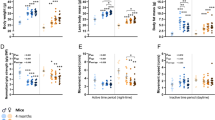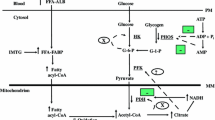Abstract
Lipin1 has been documented to play an important role in adipogenesis. In the present study, the mRNA expression level of lipin1 and its isoforms in longissimus dorsi muscle were determined by semi-quantification RT-PCR in lean PIC and obese Rongchang pigs. Further, we determined mRNA expression for lipin1 and its two isoforms in Rongchang obese pigs which had either a high or low intramuscular fat content. We demonstrate for the first time that porcine lipin1 has two alternative forms, lipin-α and lipin-β. Unlike mice and humans where the lipin-β has 99 more nucleotides than lipin-α, we found that in swine, lipin-β has 108 more nucleotides than lipin-α. Our results indicate that the longissimus dorsi muscle of Rongchang obese pigs have a higher level of mRNA expression for lipin1 and its isoforms than PIC lean pigs. Furthermore, Rongchang pigs with higher intramuscular fat content had a higher lipin1 and lipin-β mRNA expression in longissimus dorsisi muscle than Rongchang pigs with lower intramuscular fat content (P < 0.05), whereas no difference was seen in lipin-α mRNA expression between Rongchang pigs with high or low intramuscular fat. The ratio of lipin-β mRNA to lipin-α mRNA was also significantly different between Rongchang pigs distinguished by a high intramuscular fat content compared with those with low intramuscular fat (P < 0.05). These data suggested that the lipin1 gene may have a crucial effect on body lipid accumulation in pigs, whereas the lipin-β isoform may play an important role in intramuscular fat deposition in obese pigs.




Similar content being viewed by others
References
Phan J, Reue K (2005) Lipin, a lipodystrophy and obesity gene. Cell Metab 1:73–83
Suviolahti E, Reue K, Cantor RM, Phan J, Gentile M, Naukkarinen J (2006) Cross-species analyses implicate lipin1 involvement in human glucose metabolism. Hum Mol Genet 15:377–386
Donkor J, Sariahmetoglu M, Dewald J, Brindley DN, Reue K (2007) Three mammalian lipins act as phosphatidate phosphatases with distinct tissue expression patterns. J Biol Chem 282:3450–3457
Harris TE, Huffman TA, Chi A, Shabanowitz J, Hunt DF, Kumar A, Lawrence JC (2007) Insulin controls subcellular localization and multisite phosphorylation of the phosphatidic acid phosphatase, lipin1. J Biol Chem 282:277–286
Phan J, Pe′terfy M, Reue K (2004) Lipin expression preceding peroxisome proliferator-activated receptor-gamma is critical for adipogenesis in vivo and in vitro. J Biol Chem 279:29558–29564
Finck BN, Gropler MC, Chen Z, Leone TC, Croce MA, Harris TE, Lawrence JC, Kelly DP (2006) Lipin1 is an inducible amplifier of the hepatic PPAR coactivator-1 alpha regulatory pathway. Cell Metab 4:199–210
Phan J, Pe′terfy M, Reue K (2005) Biphasic expression of lipin suggests dual roles in adipocyte development. Drug News Perspect 18:5–11
Pe′terfy M, Phan J, Reue K (2005) Alternatively spliced lipin isoforms exhibit distinct expression pattern, subcellular localization, and role in adipogenesis. J Biol Chem 280:32883–32889
Cameron ND, Enser M (1991) Fatty acid composition of lipid in longissimus dorsi muscle of Duroc and British Landrace pigs and its relationship with eating quality. Meat Sci 29:295–307
Hodgson RR, Smith GC, Savell JW, Cross HR (1991) Relationships between pork loin palatability traits and physical characteristics of cooked chops. J Anim Sci 69:4858–4865
Castell AG, Cliplef RL, Poste-Flynn LM, Butler G (1994) Performance, carcass and pork characteristics of castrates and gilts self-fed diets differing in protein content and lysine: energy ratio. Can J Anim Sci 74:519–528
De Vol DL, McKeith FK, Bechtel PJ, Novakofski J, Shanks RD, Carr TR (1988) Variation in composition and palatability traits and relationships between muscle characteristics and palatability in a random sample of pork carcasses. J Anim Sci 66:385–395
He XP, Xu XW, Zhao SH, Fan B, Yu M, Zhu MJ, Li CC, Peng ZZ, Liu B (2009) Investigation of lipin1 as a candidate gene for fat deposition in pigs. Mol Biol Rep 36:1175–1180
Fang Q, Yin JD, Li FN, Zhang JX, Watford M (2009) Characterization of methionine adenosyltransferase 2beta gene expression in skeletal muscle and subcutaneous adipose tissue from obese and lean pigs. Mol Biol Rep. doi:10.1007/s11033-09-9767-0
Lu P, Li DF, Yin JD, Zhang LY, Wang ZY (2008) Flavour differences of cooked longissimus muscle from Chinese indigenous pig breeds and hybrid pig breed (Duroc × Landrace × Large White). Food Chem 107:1529–1537
Association of Official Analytical Chemists (2005) Official methods of analysis, 18th edn. Association of Official Analytical Chemists, Arlington
Lai CH, Yin JD, Li DF, Zhao LD, Qiao SY, Xing JJ (2005) Conjugated linoleic acid attenuates the production and gene expression of proinflammatory cytokines in weaned pigs challenged with lipopolysaccharide. J Nutr 135:239–244
Huffman TA, Mothe-Satney I, Lawrence JC (2002) Insulin-stimulated phosphorylation of lipin mediated by the mammalian target of rapamycin. Proc Natl Acad Sci 99:1047–1052
Liu L, Yin JD, Li W, Liu K, Peng Y, Tan PP, Ma RL (2010) Construction of a bacterial artificial chromosome library for the Rongchang pig breed and its use for the identification of genes involved in intramuscular fat deposition. Biochem Biophys Res Commun 391:1280–1284
Yao-Borengasser A, Rasouli N, Varma V, Miles LM, Phanavanh B, Starks TN (2006) Lipin expression is attenuated in adipose tissue of insulin-resistant human subjects and increases with peroxisome proliferator-activated receptor gamma activation. Diabetes 55:2811–2818
Pe′terfy M, Phan J, Reue K (2001) Lipodystrophy in the fld mouse results from mutation of a new gene encoding a nuclear protein, lipin. Nat Genet 27:121–124
Lindegaard B, Larsen LF, Hansen ABE, Gerstoft J, Pedersen BK, Reue K (2007) Adipose tissue lipin expression levels distinguish HIV patients with and without lipodystrophy. Intern J Obes 31:449–456
Reitman L (2005) The fat and thin of lipin. Cell Metab 1:5–6
Croce MA, Eagon JC, LaRiviere LL, Korenblat KM, Klein S, Finck BN (2007) Hepatic lipin1 β expression is diminished in insulin-resistant obese subjects and is reactivated by marked weight loss. Diabetes 56:2395–2399
Reue K, Zhang PX (2008) The lipin protein family: dual roles in lipid biosynthesis and gene expression. FEBS Lett 582:90–96
Acknowledgments
The authors are grateful to Professor P.A. Thacker, Department of Animal and Poultry Science, University of Saskatchewan for the paper’s modifications. This work was supported by grants and funds from the National Natural Science Foundation (u0731004), National High-tech R&D Program of China (2008AA10Z141), National Key Technology R&D Program of China (2007BAD51B02), and Chongqing Municipal Natural Science Foundation (2008BA1013).
Author information
Authors and Affiliations
Corresponding authors
Electronic supplementary material
Below is the link to the electronic supplementary material.
Rights and permissions
About this article
Cite this article
Wang, Q., Ji, C., Huang, J. et al. The mRNA of lipin1 and its isoforms are differently expressed in the longissimus dorsi muscle of obese and lean pigs. Mol Biol Rep 38, 319–325 (2011). https://doi.org/10.1007/s11033-010-0110-6
Received:
Accepted:
Published:
Issue Date:
DOI: https://doi.org/10.1007/s11033-010-0110-6




